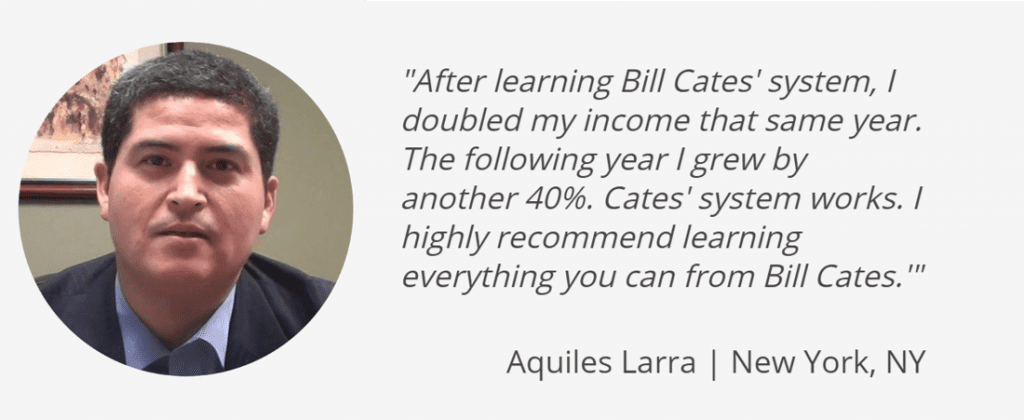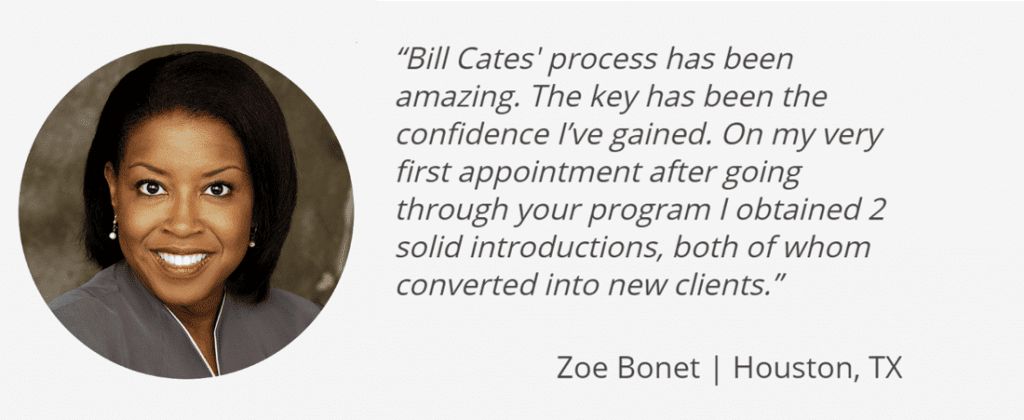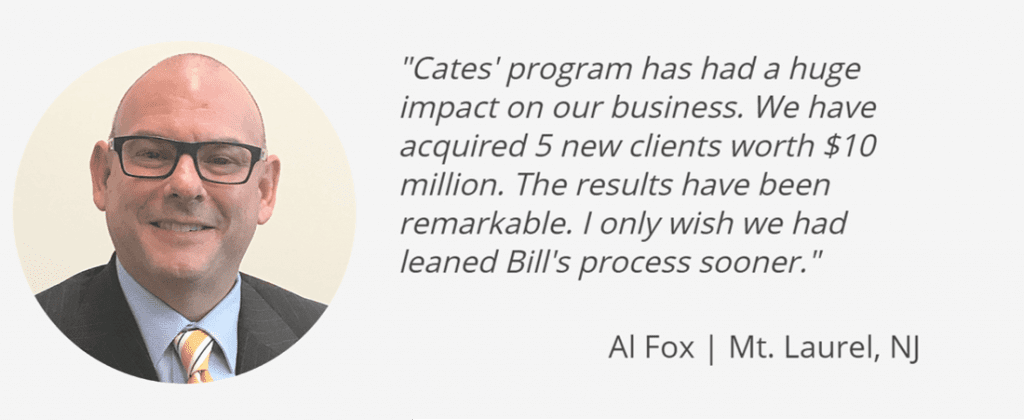How Do You Make Asking for Introductions a Habit?

In his book, Atomic Habits, James Clear writes, “Your outcomes are a lagging measure of your habits. Your net worth is a lagging measure of your financial habits. Your weight is a lagging measure of your eating habits. Your knowledge is a lagging measure of your learning habits. Your clutter is a lagging measure of your cleaning habits. You get what you repeat.”
Therefore, your current results related to referrals and introductions are the byproduct of your thinking and acting in the areas of client engagement and proactivity.
In my work with advisors, there are many habits I help them establish related to acquiring new clients. A few of these are: enhancing client engagement, telling your client-focused why, having value discussions, using value recognizing statements to promote introductions, asking for introductions (without sounding or feeling creepy), and solidifying an effective introduction.
In this article, I hope to provide you with some insight, principles, and specific tactics to help you cement the awareness and actions of being appropriately proactive for introductions.
The Neuroscience of Habits
Have you ever heard the statement, “It takes 21 days to create a new habit?”
Well, don’t believe it. It depends on the habit you’re trying to create and the emotional baggage you bring to that action. Complicated habits take longer to establish. And when fear is involved, the habit may never get established – like asking for introductions.
The Role of Neural Pathways:
Habits are formed through the creation and strengthening of neural pathways in the brain. When you repeatedly engage in a behavior, the neural connections associated with that behavior become more efficient and streamlined. Over time, these connections solidify, making the behavior more automatic and less reliant on conscious effort.
The Habit Formation Timeline:
A landmark study conducted by Phillippa Lally and her colleagues at University College London examined how long it takes for habits to form. The researchers found that on average, it took participants about 66 days of consistent repetition for a new behavior to become ingrained as a habit. However, this timeline varied widely among individuals, ranging from 18 to 254 days. The study emphasized that habit formation is a gradual process influenced by various factors, such as the complexity of the behavior and the individual’s level of commitment.
The Importance of Consistency:
Consistency is a crucial factor in habit formation. Regularly engaging in a behavior helps strengthen the neural pathways associated with that habit. The more frequently you repeat the behavior, the faster the habit is likely to develop. It is worth noting that missing a day or two during the habit-building process does not completely reset your progress, but it may slow down the development of the habit.
Maintenance and Long-Term Sustainability:
Creating a new habit is just the first step. Sustaining the habit over the long term requires ongoing commitment and reinforcement. Even after a habit becomes automatic, occasional reinforcement and reminders can help solidify it further and prevent relapses.
Applying the Atomic Habit Formula to Asking for Introductions
By applying the principles outlined by James Clear in his book Atomic Habits, you can harness the power of small actions and incremental progress to build lasting habits – with regard to referrals and introductions or any other desired behavior.
The Atomic Habits Formula: Cue, Craving, Response, Reward:
The foundation of the Atomic Habits Formula lies in its four-step process: Cue, Craving, Response, and Reward. I’ll break down each step of Clear’s formula and relate it to referrals/introductions.
- Cue: Identify a specific trigger that will remind you to initiate the desired habit. We are becoming referable when value has been delivered and value has been recognized. One cue or trigger is what I refer to as Value Recognizing Statements. Look here for a list of triggers you can use to initiate promoting or asking for introductions: https://referralcoach.com/action-triggers-ask-for-referrals/
- Craving: Create a desire or craving for the habit. How bad do you want to bring your important value to others? Are you on a mission to do so? And/or, how bad do you want to grow your business and your income? When it comes to asking for introductions, your desire to spread your value and increase your success in the process is a critical element. Your burning desire will give you the courage to identify and eliminate your fears and take action to build your skills.
- Response: Define the exact action you will take to engage in the habit. Make it simple, specific, and achievable. My system teaches three main activities that support this step: conducting value discussions, promoting introductions, and asking for introductions.
- Reward: Establish a satisfying reward that reinforces the habit and makes it enjoyable. One might say that adding a new client to your business and the subsequent increase in revenue should be reward enough. With that said, since this behavior usually involves taking steps out of your comfort zone, I recommend you find other, little ways to celebrate anytime you take a specific action that moves you closer to your goals. Part of this can be thanking the introducer with a note and perhaps a small gift (compliance approved, of course). You can go a step further and you and your new client can thank the introducer together – say – over a meal together.
Stack Habits to Boost Consistency
James Clear suggests that one of the most effective strategies for habit formation is habit stacking. This involves linking a new habit with an existing one. By piggybacking on an established routine, you leverage the power of consistency and minimize the effort required to initiate the new habit. For example, you can start your new habit with value discussions. After a couple of weeks, you can then add promoting introductions. After you gain confidence with those two behaviors you can start to ask for possible introductions per our V.I.P.S. Method.
The Wild Card
Emotions and fears can play a significant role in your habit formation. They can influence the time it takes to establish a habit and even impact whether or not a habit is formed at all. Here’s how emotions and fears can figure into the process:
Emotional Association with the Habit:
Emotions can shape your relationship with a particular behavior. Positive emotions, such as joy, satisfaction, or pride, can reinforce the habit formation process. When we feel good about engaging in a habit, it strengthens the neural pathways associated with that behavior, making it more likely to become automatic.
Conversely, negative emotions, such as fear, anxiety, or disgust, can hinder habit formation. If you associate asking for introductions with unpleasant emotions, you may struggle to establish that behavior as a habit.
Fear and Resistance to Change:
Fear can create resistance to change and hinder habit formation. Stepping out of your comfort zones and embracing new behaviors can be intimidating, especially if they challenge deeply ingrained beliefs or routines. Fear of failure, judgment, or the unknown can all act as barriers to habit formation.
In such cases, it may take longer to establish the habit or require additional strategies to address the underlying fears. Gradual exposure, support from others, and reframing negative beliefs can help you overcome your fears and gradually build the desired habit.
You have been taking calculated steps out of your comfort zone your entire life. Promoting and asking for introductions typically require the same approach. If you’ve not been appropriately proactive for introductions up to this point, it might be unreasonable to expect you to jump in with both feet and have the habit securely in place. Per my suggestion above, stack your new habits over time. There could come a time when your new habit is so ingrained, you will look back at this time and wonder what all the fuss was about.
Enjoy the journey AND enjoy the results!
Recommended Action Step
Do yourself a favor and head over to www.CatesAcademy.com to turn your incremental growth into exponential growth by multiplying your best clients.
Virtual Referral Training is Here
Are you ready to grow your business … and change your life?
You can learn and implement our proven process while working from home or not seeing clients and prospects face to face.
Get the details and join us: www.CatesAcademyIndividuals.com







